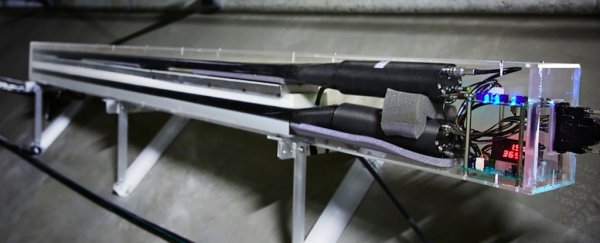We're all aware of the devastating impact that tsunamis can have, and the potential for tragedy continues to drive research into improved detection methods. A new study reports on a more usual approach to tsunami detection: the monitoring of muons.
These highly energetic, elementary particles are created as cosmic rays arrive from space, are everywhere in the atmosphere, and can harmlessly pass through just about anything, including you: 100,000 of them will pass through your body while you read this sentence.
Crucially, they can be very slightly shifted in their paths by large natural forces, including tsunamis.
An incredibly sensitive instrument is required to detect muon movement, which brings us to the Tokyo-Bay Seafloor Hyper-Kilometric Submarine Deep Detector, or the TS-HKMSDD for short. It's fitted inside the Tokyo Bay Aqua-Line expressway tunnel.
The TS-HKMSSD had the honor of detecting tsunami waves through muon ripples for the first time. Important from the perspective of earlier warnings, the detection happened in real-time and was shown to be highly accurate.
"The Tokyo-bay Seafloor Hyper KiloMetric Submarine Deep Detector is the first underwater muon observatory in the world, and it detected varying muon activity during the tsunami," says geophysicist Hiroyuki Tanaka, from the University of Tokyo in Japan.
"This variation corresponds to the ocean swells which were measured by other methods. Combining these readings means we can use muographic data to accurately model changes in sea level, bypassing other methods which come with drawbacks."
Those other methods include tide gauges, buoys in the water, satellite imagery taken from above, and various sensors in the sea itself. Muon detection, however, promises to be faster, cheaper, and easier to maintain than those approaches.
The new research outlines how the TS-HKMSDD system detected a mild tsunami passing through Tokyo Bay in September 2021, caused by a typhoon approaching Japan from the south. As the ocean swelled, the number of muons changed slightly, scattered by the volume of water.
Now that the TS-HKMSSD has shown that it can detect these muon shifts, the researchers suggest instruments like it could be installed in other tunnels in areas at risk of tsunamis and used alongside equipment such as tide gauges as part of early warning systems.
"Thanks to the success we've had from early tests such as this, similar systems are already being trialed in the UK and Finland," says Tanaka.
"Obviously, an undertaking like this comes with challenges, and installing delicate instruments in a busy tunnel could be difficult. But we are grateful for the cooperation of the agencies responsible for the Tokyo Bay tunnel."
The muon detectors that make up the TS-HKMSSD are actually rather small, around 2 meters (6.5 feet) in length. Currently, 20 of them are placed alongside the road tunnel under Tokyo Bay, working together to create the overall system.
As well as detecting approaching tsunamis, a system like this could be used to look for natural gas reserves and reveal ancient earthquake patterns.
For now, the researchers are pleased to have the TS-HKMSSD up and running as an accurate tsunami detector, which with some further work will be available for use in alerting experts to natural disasters.
"To the best of my knowledge, the tunnel is now the first active national road in the world defined as a laboratory," says Tanaka.
The research has been published in Scientific Reports.
